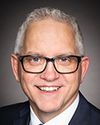Good morning. Thank you.
My name is Kirsten Agrell. I am with the International Union of Operating Engineers, Local 793. I am speaking to you from our office in Oakville, Ontario, which is in the traditional territory of several nations, including the Mississaugas of the Credit, the Anishinabe, the Chippewa, the Haudenosaunee and the Wendat peoples.
At the International Union of Operating Engineers, we have our roots in construction, but we also represent lots of workers in mining and in industry. We have about 17,000 members, and we operate throughout Ontario and in the territory of Nunavut. More recently, we represent about 1,000 people in a mining bargaining unit north of the Arctic Circle on Baffin Island, and about 15% of our members at that bargaining unit are Inuit land claims beneficiaries living in communities in the north. We've also been growing our representation of indigenous workers in Ontario, who continue to be under-represented in the skilled trades, in our view.
We also have an Operating Engineers Training Institute, which is our training arm that works with indigenous training and employment organizations to try to remove barriers to entry into the skilled trades, and our trade in particular.
As a representative for all our members, we've definitely seen the different impacts that the pandemic has had on our indigenous members as opposed to our other workers. Our other workers are also struggling, but it's been a different experience, I think, for our indigenous members.
We have recommendations in three areas, all coming through our lens, to try to help indigenous communities. Obviously, our focus is always on construction and heavy equipment.
The first thing we want to recommend is a real commitment to improving essential infrastructure, including broadband connectivity, water services and all these things that will help reduce the disproportionate risk that is being faced by our indigenous members compared with other people in non-indigenous communities.
The second thing is government assistance to remove the barriers to training—particularly having to travel to COVID-19 hot spots, to urban areas, to the cities to get training and to participate in the workforce.
Third, on the health and safety side, is to prioritize the availability of rapid testing, particularly for people in indigenous communities, so that if people are continuing to work through the lockdown and the pandemic, as many of our members have been, they're not doing so and exposing their vulnerable communities to increased risk.
On the infrastructure side, I know this committee has already heard about the impact on communities without the underlying sanitation infrastructure and with overcrowded housing. I know you've also heard about the impact on the economic side, on small businesses and tourism that are having so much trouble. Our view is that improvements to infrastructure are critical, not just for health reasons but also to participate in the economic recovery once this thing is through.
We're suggesting an immediate commitment to telecommunications construction projects with time frames set. It should be a real priority. We know our members who are right now trying to work from home or trying to help their children go to school from home are having real trouble because of Internet connectivity issues. We as an organization have been trying to ramp up our efforts to reach out to people online, and the lack of connectivity has been a problem.
Facilitating telecommunications infrastructure construction also provides training and opportunities for people to work close to their communities so they don't have to travel through Toronto.
We really support the universal broadband fund that we've heard about. We do want to say that you need to make sure that enough of that is allocated for indigenous communities to make sure that really good, lasting and quality infrastructure goes in there.
Of course, like everyone else, we're also very concerned about the boil water advisories and the sanitation. Any time people are having to leave their communities, even in southern Ontario, to get clean drinking water and go into COVID-19 red zones to do that, that's a problem. We definitely want to say don't leave that behind or reprioritize it because of COVID.
We know about the indigenous community support fund that was announced. We understand that is more for services that provide education and training, which is great. We would like to see some sort of dedicated funding for COVID infrastructure work.
We know in Ontario they've announced something called the COVID-19 resilience infrastructure fund, which I know has some federal funds too. We don't know how much, if any, of that is earmarked for indigenous communities. We certainly suggest it should be. This, as I understand it, is funding to go specifically towards retrofitting schools' and recreation centres' ventilation and to enable social distancing. If there is not such a fund specific to indigenous peoples, we think that would be a good initiative and something we'd certainly encourage and recommend.
There are other areas we want to recommend, including training. The IUOE works with the Aboriginal Apprenticeship Board of Ontario, which has identified barriers to training. Having to travel into urban areas is certainly one of them. Bringing training into indigenous communities is expensive and hard. It's a big territory. It's a big world. We need government assistance with that.
Finally, most of our workers have continued to work and have been providing essential services throughout lockdown. However, we have members coming from very vulnerable communities. Having to choose between continuing to work and potentially putting your community at risk has been very different for indigenous workers compared with some of our other members, particularly in the far north, in Baffin Island. Rapid testing and its availability to indigenous communities is something we think the government should prioritize. It would help put that final health and safety piece in to enable people who want to and are able to keep working during the pandemic.






